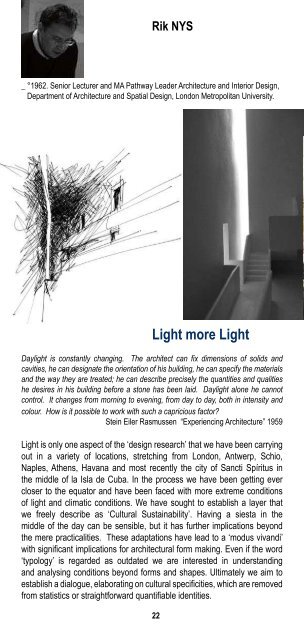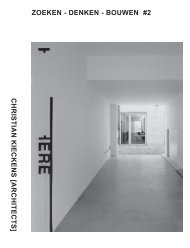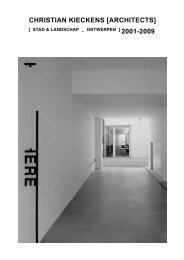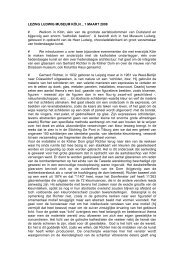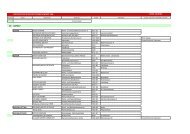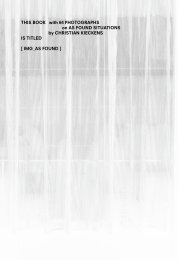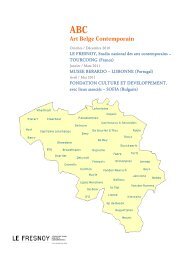03.03 > 07.03.2008 - Christian Kieckens Architects
03.03 > 07.03.2008 - Christian Kieckens Architects
03.03 > 07.03.2008 - Christian Kieckens Architects
Create successful ePaper yourself
Turn your PDF publications into a flip-book with our unique Google optimized e-Paper software.
Rik NYS<br />
Theo DEUTINGER<br />
_ °1962. Senior Lecturer and MA Pathway Leader Architecture and Interior Design,<br />
Department of Architecture and Spatial Design, London Metropolitan University.<br />
_ Theo DEUTINGER, head and founder of TD architects. Renowned for the<br />
development of SNOG’ - Snapshots of Globalisation - and his writings about<br />
the transformation of the Europe’s urban culture through cheapness. Frequently<br />
lecturing and keeps teaching engagements with the Rotterdam based Berlage<br />
Institute and the various Academies in Holland.<br />
Light more Light<br />
Daylight is constantly changing. The architect can fix dimensions of solids and<br />
cavities, he can designate the orientation of his building, he can specify the materials<br />
and the way they are treated; he can describe precisely the quantities and qualities<br />
he desires in his building before a stone has been laid. Daylight alone he cannot<br />
control. It changes from morning to evening, from day to day, both in intensity and<br />
colour. How is it possible to work with such a capricious factor?<br />
Stein Eiler Rasmussen “Experiencing Architecture” 1959<br />
Walled World<br />
The lecture is about the current global political regime that clearly<br />
defines an inside space, where people are pampered by luxury and an<br />
outside space where people fight to survive. To both, the ‘insiders’ and the<br />
‘outsiders’, this absurdity is reality.<br />
Light is only one aspect of the ‘design research’ that we have been carrying<br />
out in a variety of locations, stretching from London, Antwerp, Schio,<br />
Naples, Athens, Havana and most recently the city of Sancti Spíritus in<br />
the middle of la Isla de Cuba. In the process we have been getting ever<br />
closer to the equator and have been faced with more extreme conditions<br />
of light and climatic conditions. We have sought to establish a layer that<br />
we freely describe as ‘Cultural Sustainability’. Having a siesta in the<br />
middle of the day can be sensible, but it has further implications beyond<br />
the mere practicalities. These adaptations have lead to a ‘modus vivandi’<br />
with significant implications for architectural form making. Even if the word<br />
‘typology’ is regarded as outdated we are interested in understanding<br />
and analysing conditions beyond forms and shapes. Ultimately we aim to<br />
establish a dialogue, elaborating on cultural specificities, which are removed<br />
from statistics or straightforward quantifiable identities.<br />
22<br />
23


